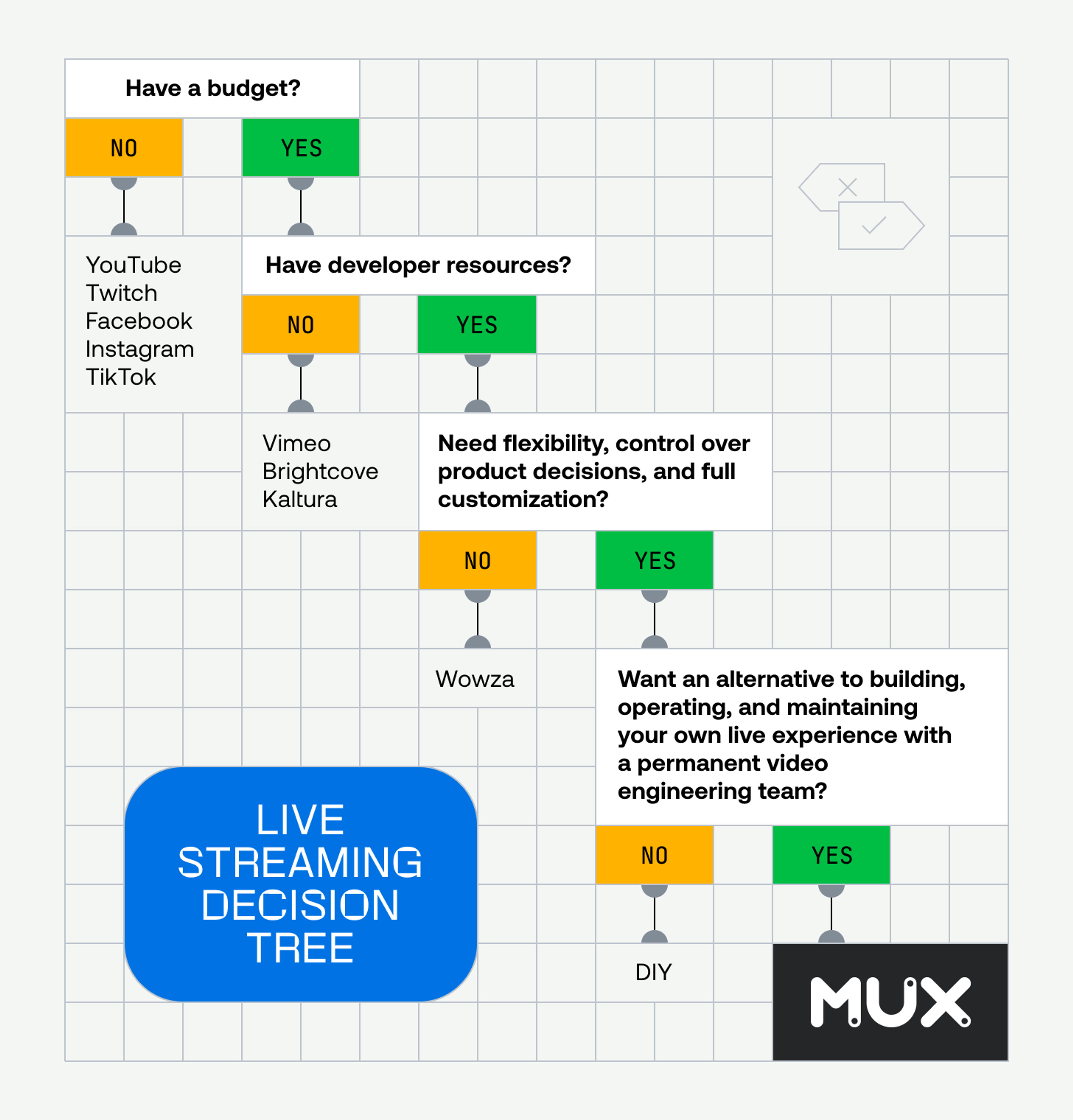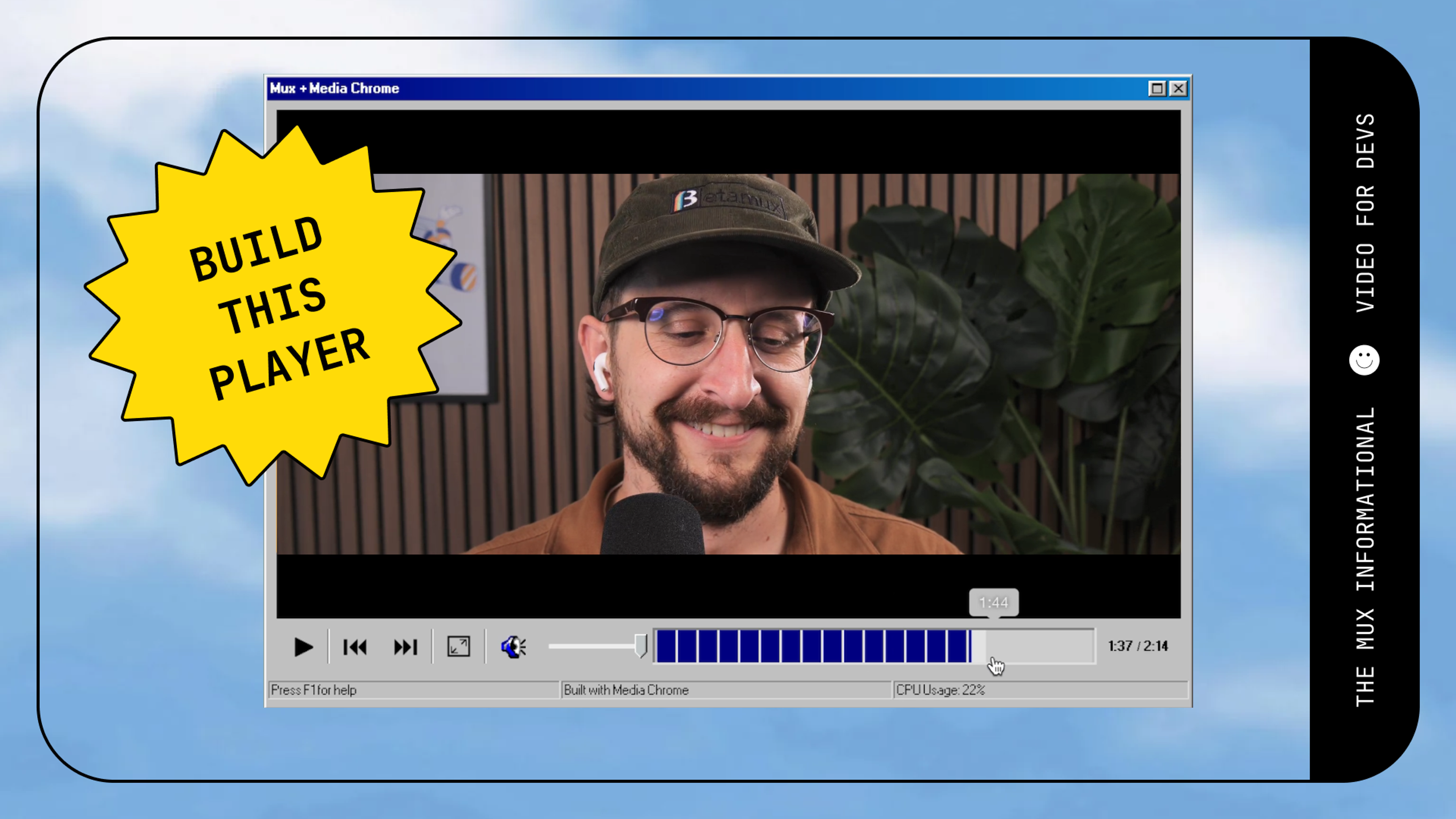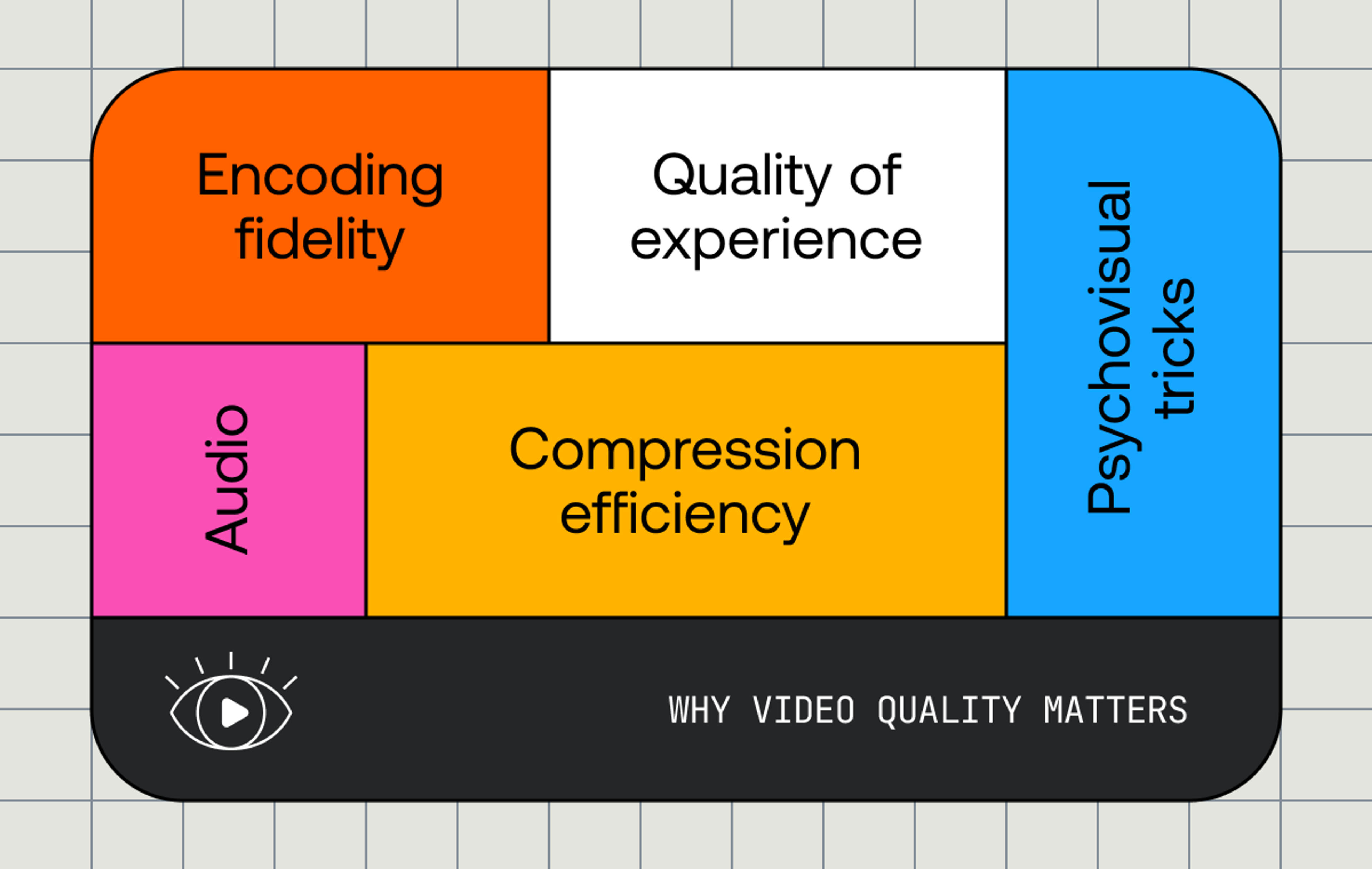UPDATED July 22, 2024: This blog has been updated to reflect the current state of live streaming platforms. To the best of our knowledge, this information is accurate at the time of the update.
The live streaming landscape is complicated, from the technology itself to the range of vendor options. If you’re new to live streaming and just starting your research, we’ll try to answer some initial questions you may have and highlight key differences between some of the most well-known live streaming platforms.
We’ve created a reference chart so you can quickly compare different platforms and see what capabilities they have for each criterion. Each one is explained more in-depth below and may help surface some qualities you may not know you wanted from a live streaming platform. This can hopefully help you decide how important each one is for your project, prioritize them, and see where you’re willing to make tradeoffs. In general, the more “out-of-the-box” a solution is, the less control you have over some potentially significant product decisions.
Then, when you’re ready, go through the decision tree at the end of the post to narrow down your options for what best suits your needs.
Platform by category
Social Media Platforms
You’re probably already familiar with the social media video platforms. With a target audience of pretty much everyone, they make it easy for users to capture content and publish it onto their specific platforms. However, if you’re looking to create your own product or application that features video, the products in this category either don’t allow for it (Instagram, Facebook, TikTok) or are the least flexible (YouTube, Twitch) compared to other platforms.
B2B or B2C | Offers low latency (<10 sec) | Choose my own player | Includes CMS | Control over UI and branding | Generate revenue without the use of ads | Developer required | Pricing model | |
|---|---|---|---|---|---|---|---|---|
YouTube | B2C | Yes | No | Yes | No | No | No | Free (ad-supported) |
Twitch | B2C | Yes | No | Yes | No | No | No | Free (ad-supported) |
B2C | Yes | No | Yes | No | No | No | Free (ad-supported) | |
B2C | Yes, but not something you control | No | Yes | No | No | No | Free (ad-supported) | |
TikTok | B2C | Yes, but not something you control | No | Yes | No | No | No | Free (ad-supported) |
Online Video Platforms
Online Video Platform (aka OVP) is a broad term and can cover a lot of different types of video solutions. Each of the products in this category can range pretty differently from each other in terms of features and capabilities. (note: this isn't an exhaustive list and you'll definitely find more OVPs out there.)
Most OVPS have a user interface (UI) to publish or embed videos, similar to the social media platforms above, but are geared towards professional content, like marketing videos. For basic functionality and customizations, like adjusting player colors to match your branding, most of these solutions don’t require a developer. For more advanced customizations and use cases, a developer would be required.
B2B or B2C | Offers low latency (<10 sec) | Choose my own player | Includes CMS | Control over UI and branding with provided player | Generate revenue without the use of ads | Developer required | Pricing model | |
|---|---|---|---|---|---|---|---|---|
Vimeo (Livestream.com) | Both | Yes | No | Yes | Limited | Yes | No | Tiered plans |
Brightcove (Ooyala) | B2B | Yes | No | Yes | Limited | Yes | No | Enterprise plans only |
Kaltura | B2B | Yes (in beta) | No | Yes | Limited | Yes | No | Enterprise plans only |
Wowza | B2B | Yes | Yes | Yes | Limited | Yes | Yes | Tiered and usage-based plans. No min. spend. |
Video APIs
Then, there’s the Video API category. These services allow for the most flexibility to customize your video experience and can provide robust delivery services so you can actually build your own OVP or social media product.
For example, if you want to build the next TikTok Live or YouTube Live, you’ll want a video service that specifically lets you build your own video platform. You couldn’t use YouTube to build your own YouTube. Plus, the service will need to have a way for your users to live stream and play back their stream.
B2B or B2C | Offers low latency (<10 sec) | Choose my own player | Includes CMS | Control over UI and branding with provided player | Generate revenue without the use of ads over UI and branding | Developer required | Pricing model | |
|---|---|---|---|---|---|---|---|---|
Mux | B2B | Yes | Yes | No | Yes | Yes | Yes | Pay-as-you-go, Startup, and Custom plans. No min. spend. |
Cloudflare Stream | B2B | Yes (beta) | Yes | No | Limited | Yes | Yes | Tiered plans |
Amazon IVS | B2B | Yes | Limited | No | Limited | Yes | Yes | Pay-as-you-go and custom plans. No min. spend. |
Explanation of criteria
#1. Live Streaming: Do they offer it?
Although this post is meant to help you narrow down a live streaming platform, we wanted to name some on-demand streaming platforms in the chart that you might have assumed offer live streaming. Update: At the time of the original post, Wowza did not offer live streaming. This criterion has been removed from the charts above.
#2. Latency: Understand your requirements.
Based on your use case, you’ll want to figure out how much latency you can get away with. This means how much delay or lag from when you capture your content to when your audience sees it (also known as “glass-to-glass” which refers to the concept of going from camera to screen).
For example, if you want your audience to interact with the streaming content you’ll need much lower latency than if you’re live streaming a concert. To find out what your recommended latency is, check out this comprehensive post that covers latency by use case.
Our chart covers options from low latency and up. Generally, most live streaming use cases can tolerate having a standard latency of 15 to 30 seconds or more. If you need ultra-low latency, your options for a video solution may quickly be short-listed. And if you have a use case that requires real-time communication (sub-second latency for things like video calls), there’s a whole other set of solution providers for it not covered here.
#3. Player: Can you choose your own?
The player controls or exposes other vital aspects of playback beyond just the controls themselves. Its functionality includes features like subtitles and captions, programmatic APIs for controlling playback, hooks for things like client-side analytics, ads, and much more. Perhaps most importantly, a modern video platform will use what's called adaptive bitrate streaming (ABR), which means they provide a few different versions of a video, also known as renditions, for the player to pick from. Different players make different decisions around how and when to switch to the different versions, so the player can make a big difference in the viewer's experience.1
Depending on what features you want for a player or how much you want to be able to control, you may or may not want to choose your own player.
#4. Content Management System: Does it come with a CMS?
A video CMS makes it easy for anyone to manage their content, including non-technical folks. This could include uploading, naming, managing, and publishing videos.
However, the platforms that provide a CMS usually require you to use it which means:
- You are often unable to integrate videos into a CMS of your own.
- It could be difficult to get your videos out, essentially keeping you locked into using them.
#5. Customization: How much control do you get over UI and branding?
Customization can mean a broad range of things and there’s a lot of UI detail you may not have thought about yet. It can include, but isn’t limited to: the experience around the player (does it bleed to the edge or have a border), within the player itself like what the progress bar and controls look like, navigation on how to skip to the previous or next title, etc.
For this criterion, we focused on the player provided by the platform and our answers range from “No” to “Limited” to “Yes.” Here’s what we mean by each of those:
- No: You can’t customize the player to reflect your branding or how the video shows up when you embed it. These solutions may be easy to use but you pretty much have to take what you get for how it looks.
- Limited: You may be able to edit player colors to reflect your brand or pay a premium to remove their branding but you won’t be able to customize much more than that.
- Yes: You can use whichever player you want and have full control over how your video looks in your product or application. Want to add swiping capability to videos or your own watermark? No problem.
#6. Revenue: What business model do you want to adopt?
If content is the product that you’re trying to monetize, the three most popular business models are ads, subscriptions, and transactional. YouTube set the industry standard for the ad-based revenue model and there’s a whole industry around ad-insertion technology.
If you don’t want ads to interrupt your content, you could adopt a subscription or transactional model. Subscription Video On Demand (SVOD) is like Netflix where you pay a fee to have access to all the content. Transactional Video On Demand (TVOD) is like the Apple store or Amazon Prime Video where you pay per title you want to watch.
#7. Development: Do you have technical resources you can dedicate to your video project?
Depending on your use case and the resources allocated to your project, this could be a deciding factor for you.
A lot of video platforms have evolved to be non-technical and user-friendly so, for example, if your marketing department is looking to do a one-off live tutorial video and embed it into an existing website, they could likely use an OVP without requiring any or minimal engineering resources. However, if the overall business is investing in unique content that requires tiered paid access, or live experiences built into a product or app, you’ll likely need developer resources to build this type of customized experience.
#8. Pricing: How much of a commitment are you willing to make?
Finally, we're at pricing. Like #7, this is a constraint that could make or break an option for you. The good news is that even if you find yourself needing to use a solution that allows for the most customization and control for your video experience, the pricing ranges from pay-as-you-go to enterprise contracts so you can find a solution to fit any budget.
Bonus. Features: Does it support advanced features?
As a bonus, it’s good to know if the platform you’re choosing is compatible with features that will enhance your streaming and keep you ready for the future. Support for Secure Reliable Trasport (SRT), a streaming input protocol, allows you to deliver reliable live streaming even over less reliable networks. High Efficiency Video Coding (HEVC) is a modern video codec. Support for HEVC gives you bitrate and quality control so you can provide a better experience for your viewers. Live health analytics ensures your streams are running smoothly and anticipate potential issues. Features like live instant clipping allow you to create clips of your stream, instantly, without re-encoding a brand-new video asset.
SRT support | Live HEVC support | Live health indicator | Live health dashboard | Live instant clipping | |
|---|---|---|---|---|---|
YouTube | Closed beta | Yes | Yes | No | No |
Twitch | No | No | Yes | Yes | No |
No | No | Yes | Yes | No | |
No | No | No | No | No | |
TikTok | No | Yes | No | No | No |
Vimeo | No | No | Yes | Yes | No |
Brightcove | Yes | No | Yes | Yes | No |
Kaltura | Yes | No | Yes | No | No |
Wowza | Yes | Yes | No* | No* | No |
Cloudflare Stream | Yes | No | Yes | No | In beta |
Amazon IVS | Yes | No | Yes | No | No |
Mux | Yes | Yes | Yes | Yes | Yes |
*At the time of this post, Wowza only offers live health metrics on their legacy product
Closing + Decision tree
As you can see there are a ton of options for live streaming platforms. There’s a range of capabilities you can choose from but, just like other product categories, there’s not one platform that will (or necessarily should) check every box. You can, however, find a live streaming video service that best suits your use case and mix of criteria.
Based on the criteria and different categories of platforms, we’ve created this decision tree to help point you in the right direction.

If you land at Mux and are wondering whether it’s a good fit, feel free to reach out and we’ll figure it out together!



